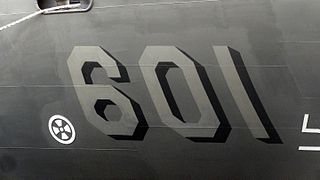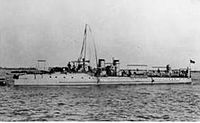- Portrait of Mistral (1901) by Marius Bar
- Mistral (1923) as HMS Mistral, before being handed over to the Free French Forces
- Mistral (L9013) in Toulon harbour
Related Research Articles
The United States Navy, United States Coast Guard, and United States National Oceanic and Atmospheric Administration (NOAA) use a hull classification symbol to identify their ships by type and by individual ship within a type. The system is analogous to the pennant number system that the Royal Navy and other European and Commonwealth navies use.

A warship or combatant ship is a naval ship that is built and primarily intended for naval warfare. Usually they belong to the armed forces of a state. As well as being armed, warships are designed to withstand damage and are usually faster and more maneuverable than merchant ships. Unlike a merchant ship, which carries cargo, a warship typically carries only weapons, ammunition and supplies for its crew. Warships usually belong to a navy, though they have also been operated by individuals, cooperatives and corporations.

In the Royal Navy and other navies of Europe and the Commonwealth of Nations, ships are identified by pennant number. Historically, naval ships flew a flag that identified a flotilla or type of vessel. For example, the Royal Navy used a red burgee for torpedo boats and a pennant with an H for torpedo boat destroyers. Adding a number to the type-identifying flag uniquely identified each ship.
USS Shubrick may refer to:

Numerous French vessels have borne the name Téméraire. Note that several British ships have had the same name, see HMS Temeraire.

The Bourrasque class was a group of twelve French Navy destroyers (torpilleur) laid down in 1923 and in service from 1926 to 1950. Along with the heavier Chacal class, they were part of a plan to modernise the French fleet after the First World War. The Bourrasques were smaller and slower than the Chacals, but were nonetheless comparable with the British W class. The class saw varied service in the Second World War, in five different navies, on both sides. These ships were named after types of wind.
Five ships of the French Navy have borne the name Bouvet in honour of François Joseph Bouvet.
Eleven ships of the French Navy have borne the name Renard, after the Fox or the character Reynard. The name was also popular for privateers.
Twelve ships of the French Navy have borne the name Entreprenant and four Entreprenante, after the French word for "enterprising"
At least six ships of the Royal Navy have borne the name HMS Sprightly:

Six French ships of the French Navy have borne the name Fantasque ("capricious"):
Twelve ships of the French Navy have borne the name Thétis in honour of nereid and sea nymph Thetis:
Six ships of the French Navy have borne the name of Borée, in honour of Boreas.
Many ships of the French Navy have borne the name Audacieux or Audacieuse, which means audacious in French, including:
Fifteen ships of the French Navy have borne the name Seine in honour of the Seine river:
Eight ships of the French Navy have borne the name Guêpe ("wasp"):
The Le Fier class was a series of sea-going torpedo boats built for the French Navy. Laid down in 1940, the ships were incomplete as of the fall of France and remained unfinished for the rest of World War II.
Six ships of the Hellenic Navy have borne the name Chios (Χίος), named after the island of Chios:
At least four ships of the French Navy have borne the name Siroco:
Twenty-two ships of the French Navy have borne the name Actif ("Active"):


